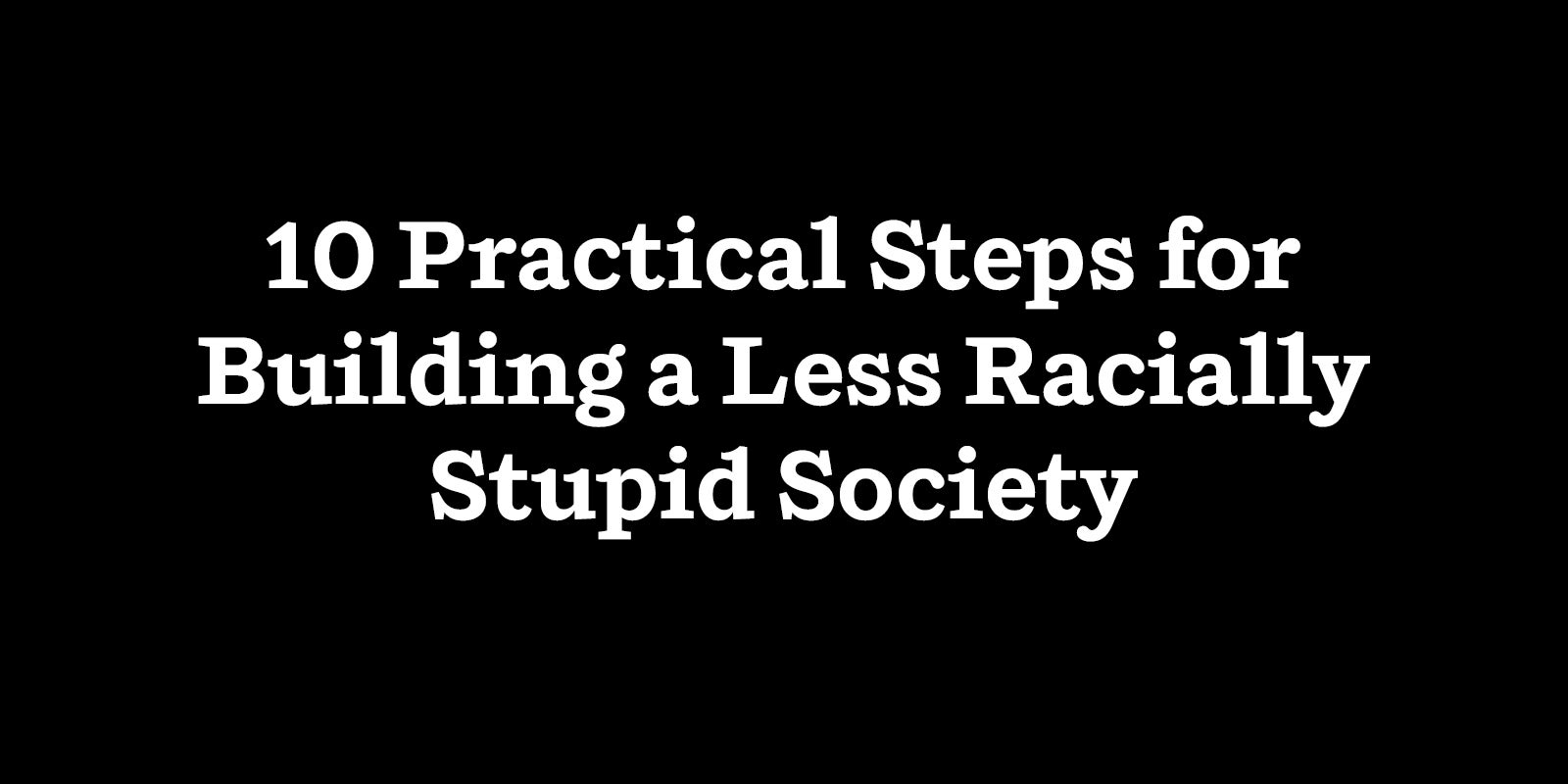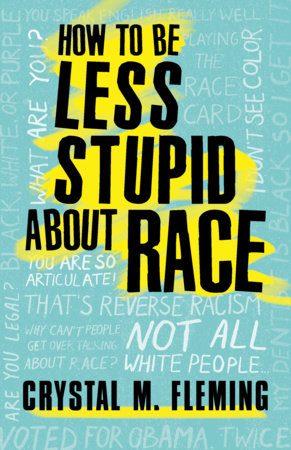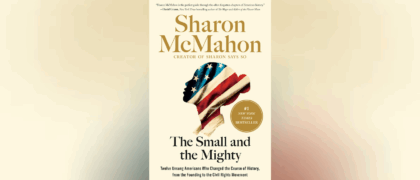While each person’s individual path will differ, here are ten suggestions for steps we can all take, right now, to build a less racist—and racially stupid—society. Most of these recommendations can also be implemented by organizations, communities of faith, businesses, and other groups that are ready to begin the hard work of undoing racism.
1. RELINQUISH MAGICAL THINKING.
This one’s hard. Really hard. But it’s so important that I’m listing it first. People often tell me things like “You’d think our society would be over racism by now!” I want to respond, “Why? Because you’ve been personally working to end it? Or because you thought someone else would do the work you’re not doing?” Listen. I know it’s tempting to wish racism away—to just sort of assume that there’s an inevitability to progress. But if you want to be less stupid about race, you need to let that shit go right now. There is no quick fix for racism. Go back and read that sentence. Then tell a friend. There’s! No! Quick! Fix! None.
Racial oppression is so intrinsically violent, so ghastly and inhumane, that facing it in its full, catastrophic splendor is almost more than the mind can handle. And so, given that it’s human nature to avoid what’s unpleasant, many minds do not handle it at all. And then there are those who cling to the fantasy that racism can be easily eradicated simply because they’ve never studied it—and so they are unfamiliar with the scope of its historical, economic, psychological, sociological, environmental, and health dynamics.
If you want to pursue the cause of social justice, give up the need for quick fixes and gird your loins for a long struggle. To sustain your work for the long haul, you’ll have to build up your reserves of resilience, self-care, community care, and courage. You’ll have to nurture your capacity for hope, humor, love, and connection, even, and especially, in the midst of oppression. What keeps me going, personally, is a deep and abiding commitment to spiritual practice and my experience of God’s presence—not in a specific church, temple, or other place of worship but in every face and every situation I encounter in this life. Laughter helps too. As does friendship. And meditation. And spending time in nature. And really good wine.
2. CRITICALLY ASSESS YOUR RACIAL SOCIALIZATION.
If you want to be an antiracist change agent, you’re going to have to think long and hard about your own racial socialization. Most of us were not taught to acknowledge the impact of racial ideas, scripts, and behavior on our upbringing and values, but that’s the kind of internal work that’s required for addressing racism. It’s easier to pretend that racism is someone else’s problem, but the truth is that none of us is immune. I like to joke that many whites, perhaps especially liberals, are prone to believing this myth: I am magically untouched by the racist society that socialized me. But there are also minorities who pretend to be exempt from the dynamics of internalized oppression or the scourge of colorism and prejudice. We have all been in the sunken place, and it does us no good to claim otherwise.
Although these questions are primarily geared toward white women’s racial consciousness-raising, I think they could be useful to folks from a wide variety of backgrounds—including people of color. Examples include
- When were you first aware that there was such a thing as race and racial differences? How old were you? Recall an incident if you can.
- What kind of contact did you have with people of different races?
- How did you first experience racism? From whom did you learn it? How did it function in your perception of yourself?
- When were you first aware that there was such a thing as anti-Semitism?
- What kind of messages did you get about race as you entered adolescence? Did your group of friends change?
- When you were growing up, what kind of information did you get about Black people through the media? How much of it was specifically about Black men?
The more aware we are of our racial socialization, the more empowered we are to challenge our biases and our conditioning. This is life-long work, and I recommend using the tools of mindfulness and meditation to cultivate compassion for yourself and others as you embark on this journey.
3. START OR JOIN AN ANTIRACIST STUDY GROUP AND SHARE WHAT YOU LEARN ABOUT SYSTEMIC RACISM.
Making a long-term commitment to challenging racism also requires a lifetime of learning. Even as an educator and an expert on racism, I am constantly seeking out new information to address gaps in my knowledge and am humbled by how much more I have to learn. Just the other day I learned that the first Europeans were brown-skinned Africans who arrived from the motherland forty thousand years ago and that “white” or pale skin did not become widespread among Europeans until about eight thousand years ago. This completely upends our conventional thinking about whiteness and Europeanness. Recent DNA analysis also indicates that the first British settlers had dark skin, dark curly hair—and blue eyes. I mean, damn. The more you know.
If you have a leadership role in an organization, institution, or corporation you can help by investing in educational resources. As part of your antiracism curriculum, be sure to integrate an intersectional approach. Antiracists must draw connections between systemic racism and other axes of domination (e.g., class oppression, (hetero)sexism, and ableism to name a few). As you commit to learning about systemic racism, you should also think critically about the links between racial injustice, capitalist oppression, and sexism.
Look into your local histories of slavery and abolitionism to get a sense of whether and to what extent racist violence, segregation, or restrictive covenants favored whites and excluded people of color in your town. Just as important? The history of antiracist struggles and mobilizations in your locality. Were there activists or rebellions that stood up against the racial power structure? Take a trip to your neighborhood library or bookstore (assuming it has not yet been put out of business by Amazon) and see what you can find out.
As you learn about systemic racism, you can begin to take an active role in combating racial denial by raising racial awareness (and most importantly, racism-awareness). Think about your own community and social connections and look for opportunities to share resources.
Consider bringing in antiracist experts and activists to educate members of organizations to which you belong. Through consciousness-raising, we can collectively move from an epistemology of racial ignorance to an epistemology of racial awareness.
4. EMPOWER YOUNG PEOPLE TO UNDERSTAND SYSTEMIC RACISM.
The question of whether and when to address the harsh realities of racism with children is a tricky matter, but many experts agree that it is important to provide young people with age-appropriate information about the existence of racism. In part, this is because research has demonstrated, time and time again, that children begin to pick up society’s harmful prejudices at an early age. An actionable step might include seeking out educational resources for addressing racism with children. (Hint: Ask them questions about their own experiences and observations before launching into a history lesson!) And, perhaps most importantly, help ensure that children and adolescents in your sphere of influence understand that race is not just about “skin color” or “seeing race.” It’s a systemic problem that’s going to require collective mobilization to bring about enduring change—and youth have an important role to play in dismantling white supremacy.
5. RECOGNIZE AND REJECT FALSE EQUIVALENCIES.
The myth of color blindness, which rose to prominence after the civil rights movement, relies on erasing the difference between those who benefit from white supremacy and those who suffer from its pathological effects. The most prominent form of this false equivalency is the dumbass idea of “reverse racism,” the notion that people of color who hold prejudiced views or even behave in a discriminatory manner are “racist” in the same way that white people are racist.
Of course, anyone can be prejudiced. Anyone can be a jackass. But in a white supremacist society, only people socially defined as white—those who benefit from white supremacy—can occupy the structural position of a racist. With that said, it is absolutely true that nonwhites can perpetuate racist ideas, can cooperate with white supremacy, and can express prejudiced beliefs. Nonwhites can also exercise dominance and oppression along related axes of oppression (e.g., class, gender, sexuality, and ability). But nonwhites, at the present time, do not have the economic or political power to exercise or collectively benefit from systemic racism in the United States, and this, after all, is what it means to be racist. In order to promote the cause of racial justice, antiracists need to recognize and actively reject false equivalencies between dominant and dominated groups.
6. DISRUPT RACIST PRACTICES. GET COMFORTABLE CALLING SHIT OUT.
If you’re not making powerful white people uncomfortable, you’re doing antiracism wrong. Many people of color are already accustomed to not only experiencing racism but also bearing the burden of calling the shit out. And quite frankly, we’re tired of this shit. This is particularly true for those of us who study or work in predominately white institutions. Let the record reflect: white supremacy persists, to a great degree, because of white folks’ refusal to aggressively challenge other whites on their racism. Because most whites live highly segregated lives, they typically face great social pressure to maintain smooth relations with white friends, family members, and coworkers—including those who routinely express racist views and behave in a discriminatory manner.
So, white people: y’all need to team up with your antiracist homies, leverage your social influence, stand up against racist behavior, and be willing to make your racist family members, friends, and/or colleagues uncomfortable. Even more to the point: white folks need to make a proactive decision to do this work, rather than rely on people of color (who are already subject to the terror of racial violence) to pick up your slack and carry the burden of dismantling oppression. Make heroes out of antiracists.
7. GET ORGANIZED! SUPPORT THE WORK OF ANTIRACIST ORGANIZATIONS, EDUCATORS, AND ACTIVISTS.
The most intelligent way to address a systemic problem is to approach it systematically, which involves organizing and mobilizing collective action. It’s important to know that we cannot effectively bring about racial transformation through individual action alone—we have to work together with like-minded people. Even if you aren’t a big fan of joining groups, you can certainly learn about and support their work. I recommend identifying organizations that draw intersectional connections between racial oppression, class inequality, and other axes of domination, such as Project NIA (which works to radically reduce the detention and incarceration of young people), Black Lives Matter, the African American Policy Forum, and the Transgender Law Center.
White readers may want to specifically seek out a white antiracist organization, such as SURJ (Showing Up for Racial Justice). You might support the intellectual and political labor of freedom fighters and radical dreamers organizing to abolish capitalist oppression, prisons, and even the police. If all of this sounds extreme or naive to you (as it did to me, initially), at least take the time to learn more about why imagining a way of relating to each other and solving our social problems without economic parasitism, prisons, state violence, or policing is valuable.
8. AMPLIFY THE VOICES OF BLACK WOMEN, INDIGENOUS WOMEN, AND WOMEN OF COLOR.
You may be wondering why I didn’t just say “Amplify the voices of black people and people of color.” Well, the reality is that men’s voices are (still) amplified over women as a matter of course. If we’re going to get serious about disrupting racism, we’re going to need to center intersectionality. This means lifting up and learning from nonwhite women and femmes, particularly disabled women, queer women, trans women, and working-class and poor women of color. We can no longer afford to collectively treat the unique oppression of black women and women of color as a side issue or keep on crowning an uninterrupted series of black and brown men as the spokespeople for the Race Problem.
Read and support the work of a wide variety of racially marginalized women like Shailja Patel, Sara Ahmed, Janet Mock, Audre Lorde, Lorraine Hansberry, Kimberlé Crenshaw, Ijeoma Oluo, Issa Rae, Mona Eltahawy, and Rokhaya Diallo. Stop treating black women and women of color like afterthoughts. You can challenge a great deal of racial stupidity today simply by centering women’s experiences in discussions about racial oppression. Say our names.
9. SHIFT RESOURCES TO MARGINALIZED PEOPLE.
Institutions, organizations, politicians, and everyday citizens can all make it a regular, ongoing practice to look for ways of disrupting the status quo by investing material, cultural, social, and political resources into vulnerable communities. This kind of transformation might take the form of reparations or innovative policy proposals like baby bonds. But it can also look like creating opportunities to hire and increase the salaries of minorities, rolling back the excess greed that drives neoliberalism, expanding the safety net, providing Medicare for all, and ensuring that we invest more in education and our collective well-being than in warfare, policing, and mass incarceration. All too often, businesses, universities, and political groups content themselves with diversity at the lowest levels of power and normalize the continued dominance of white men at the top. This needs to change. Political and economic resources should be redistributed throughout our society—and this includes shifting away from the norm of white male hegemony to a new norm of shared prosperity and diverse leadership.
10. CHOOSE AN AREA OF IMPACT THAT LEVERAGES YOUR UNIQUE TALENTS.
When students ask me for direction, I try to convey to them the importance of choosing an area of impact that bridges their interests with their unique talents. But in order to do this, you have to invest some time and energy in self-exploration. Perhaps you have a knack for artistic expression, a facility with numbers, a photographic memory, or an interest in history. How can you leverage your set of skills and talents to help improve society? Answering this question can help you figure out what piece of the social justice puzzle you want to focus on, knowing that you can’t do everything. You should also remember that your answer to this question can change over time. Maybe you get involved with political activism for a while and then move on to empowering communities of color through education or health-care advocacy. You don’t have to be a “single-issue” antiracist, but I do recommend selecting a few areas to build your knowledge and maximize your impact.
About the Author
Crystal Marie Fleming, PhD, is a writer and sociologist who researches racism in the United States and abroad. She earned degrees from Wellesley College and Harvard University and is associate professor of sociology and Africana studies at Stony Brook University. Fleming writes about race, sexuality, and politics for publications including The Root, Black Agenda Report, Vox, and Everyday Feminism, and she has tens of thousands of followers on social media. She is the author of Resurrecting Slavery: Racial Legacies and White Supremacy in France and How to Be Less Stupid About Race: On Racism, White Supremacy, and the Racial Divide. Connect with her at crystalfleming.com and follow her on Twitter at @alwaystheself.






